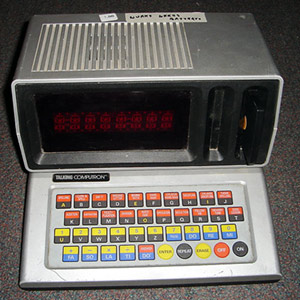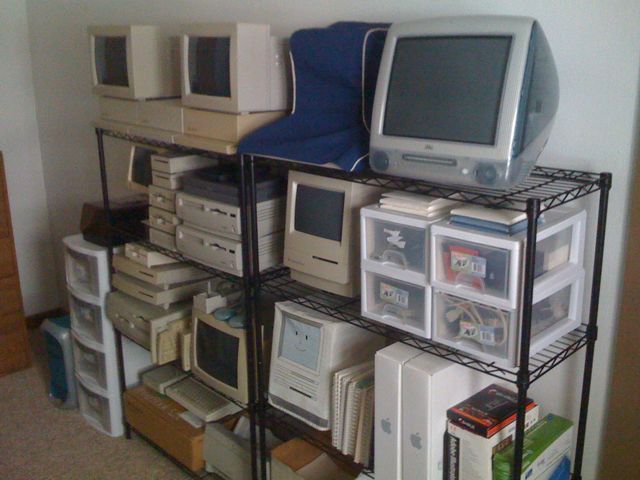There are still about a half-dozen still in storage, but the Wall-o-Macs is shaping up quite nicely.
Tag Archives: computer
Obfuscation Rules
It took days of failed attempts, but I’m now reliving my childhood. I figured out how to write Apple II disk images to those big 5.25 floppies. Sure there are emulators out there. Sure it is a whole lot easier to just download the disk image and play on a new iMac. It just isn’t the same. There is something truly satisfying about hearing those big drives click away. Here is what it took.
- Mac OS 10.5 on an Intel iMac to download the disk images and drop them in a shared folder to go to…
- Mac OS 10.4.9 on a PPC iMac that has support for…
- Mac OS 9.2.2 which can run Bernie II the Rescue, an Apple IIgs emulator that can manipulate the files, which can then be transfered via 3.5 floppy to…
- Mac OS 7.0.1 on a Macintosh Classic which can write to ProDOS disks, which are compatible with…
- Apple GSOS 6.0.1 which runs on an Apple IIgs.
What is the end product for all this hassle? Number Munchers, Odell Lake, Battleship, and Hitchhiker’s Guide to the Galaxy are just the beginning. Oregon Trail… I’ve got my eyes on you next.
Apple IIgs Resurrected
A week or two ago I purchased two computers from someone through craigslist. One of the computers was the most powerful Apple II model ever built, the IIgs (ROM 3). This computer presented itself with some challenges to bring it back to life. Unlike the Apple II’s I grew up with, this model did not have a 5.25 floppy, but rather a 3.5. The drive also posed a problem in that it would not read standard 1.44mb 3.5 floppies, but 800k formatted disks.
In order to get software installed I had to first buy an external USB floppy drive. Anyone you know still use a floppy drive? Didn’t think so. Then I downloaded the software from various sites around the web, loaded it onto floppies, then transferred it all to my 1991 Macintosh Classic. Once all the necessary files were transferred I modified the floppies into 800k disks by taping the top left hole. This process tricks the drive into formatting a 800k disk when promted in Mac OS 7. Once those disks were written it was time to install GS/OS 6.0.1 on the IIgs. Because I only have one floppy drive on the IIgs I had to switch the install disk and target disk more than 50 times. It would load a small portion of the OS, then copy it to the disk, and then repeat the process over and over until done. If there was a second drive I would not have had to switch the disks.

Even though the OS is nearly 20 years old the GS/OS is really impressive. It mimics Mac OS 7’s feel and style as best it can with the hardware resources available. It is hard to believe that the whole device runs from a 800k disk. Steve Wozniak’s brilliance still shines through on this machine.
On a side note, I have come to appreciate how fast network infrastructure has improved in the past five years alone. Phones, television, internet, and a variety of other network connected devices now share the internet as their backbone. Their integration into our lives often goes by unnoticed until they cease to function properly. Before the days of wireless internet, or even the proliferation of ethernet networks, data was transported by “sneakernet.” Someone physically had to transport media to its destination, insert the disc, and eject it.
RetroMacCast
The folks over at RetroMacCast were kind enough to include a photo I sent in to them in their podcast. Be sure to check out Episode 18 where they read my letter as their first item of discussion. You can download RetroMacCast with iTunes (preferred) or directly from their website.
The Talking Computron

EDITOR’S NOTE – MARCH 24, 2009 – I get a lot of traffic to this story, a few e-mails asking questions, and great comments left for this blog entry. I’m really curious how you readers are finding this bit of text. Please leave a comment telling me how!
Behold, puny mortals, my latest thrift store acquisition! St. Vincent De Paul got the shaft as I saved 50% off this $1 piece of raw computational power. The 1986 Talking Computron by VTel features a membrane keyboard, eight-character red LED alpha-numeric display, 20 built-in programs, cartridge slot, and even a real electronic voice! It is powered by 6 C batteries or a 9v 300mA adapter. On the top of the unit written on tape it says verbatim “WURKS NEEDS BATTERYS.” Because I do not have C batteries available to power the unit I am left to wildly speculate as to the true capabilities of this device. To put this all into perspective I will compare and contrast with another deus ex machina, the Sony PlayStation 3.
- The Talking Computron has a built-in keyboard whereas the PS3 only has USB ports to plug one in. Advantage Computron.
- Both systems have fonts on the side of the machine that demand your focused attention. Advantage none.
- “Talking Computron” is 16 characters long while “PLAYSTATION 3” is only 11. Advantage Computron. Plus one for correct spacing for Computron. Minus one for PS3 for using CAPS LOCK.
- Both systems produce an image that hurts to look at in low definition. Advantage none.
- Talking Computron came with twenty built-in games plus a cartridge called “Dress Up and Theatre” while PS3 came with the Cross Media Bar. Advantage Computron.
- PS3 collects dust superbly on its shiny black surface. Talking Computron collects dust in impossible to clean edges. Advantage none.
- PS3 can interface with the PlayStation Portable. The Talking Computron has unknown interface capabilities. Which is scarier? The known or the unknown? Talking Computron plus one.
- I am drinking a tasty beverage responsibly whilst writing this. Plus one to me for responsible drinking and plus another for usage of “whilst.” Minus one for drinking it alone.
- Talking Computron features built in math software while the PS3 does not. Obviously people who blew $600 do not know the value of money. Advantage Talking Computron.
- The PS3 and Talking Computron both lack rumble functionality. Advantage none.
According to my rudimentary and lackluster American public education math skills the final totals come to Talking Computron with 6, PS3 with -1, and myself with a point. Not bad for a $0.50 investment.
September 3, 2009 Update: The Talking Computron sold for $23 on eBay sometime last month. I had no clue that it would fetch so much, let alone sell at all.
